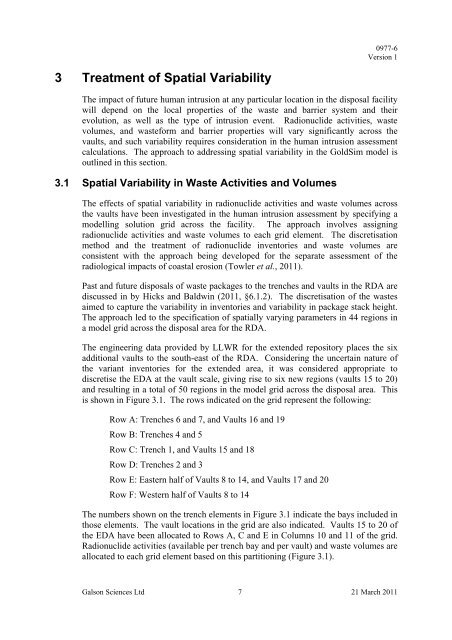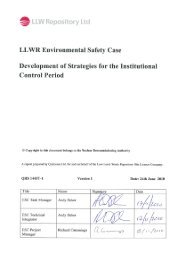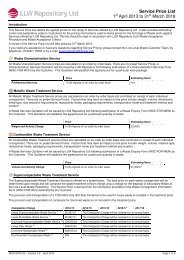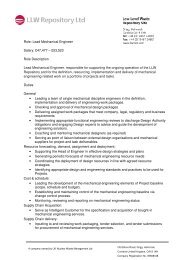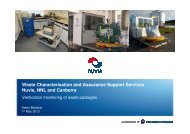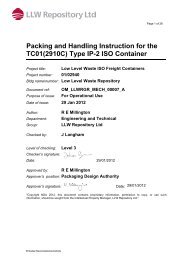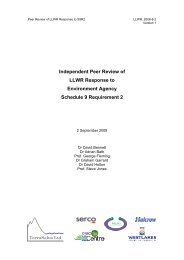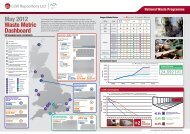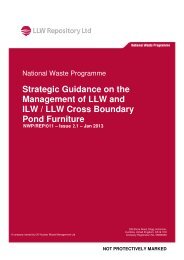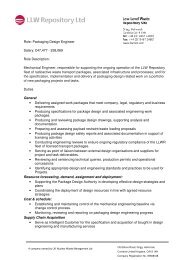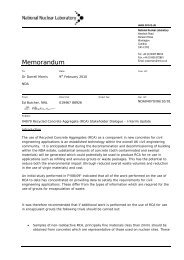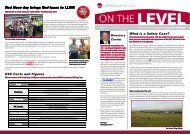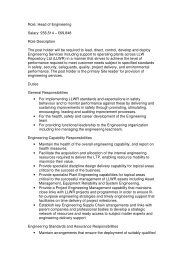Baldwin TD and Hicks TW, Assessment Calculations for Human ...
Baldwin TD and Hicks TW, Assessment Calculations for Human ...
Baldwin TD and Hicks TW, Assessment Calculations for Human ...
Create successful ePaper yourself
Turn your PDF publications into a flip-book with our unique Google optimized e-Paper software.
0977-6Version 13 Treatment of Spatial VariabilityThe impact of future human intrusion at any particular location in the disposal facilitywill depend on the local properties of the waste <strong>and</strong> barrier system <strong>and</strong> theirevolution, as well as the type of intrusion event. Radionuclide activities, wastevolumes, <strong>and</strong> waste<strong>for</strong>m <strong>and</strong> barrier properties will vary significantly across thevaults, <strong>and</strong> such variability requires consideration in the human intrusion assessmentcalculations. The approach to addressing spatial variability in the GoldSim model isoutlined in this section.3.1 Spatial Variability in Waste Activities <strong>and</strong> VolumesThe effects of spatial variability in radionuclide activities <strong>and</strong> waste volumes acrossthe vaults have been investigated in the human intrusion assessment by specifying amodelling solution grid across the facility. The approach involves assigningradionuclide activities <strong>and</strong> waste volumes to each grid element. The discretisationmethod <strong>and</strong> the treatment of radionuclide inventories <strong>and</strong> waste volumes areconsistent with the approach being developed <strong>for</strong> the separate assessment of theradiological impacts of coastal erosion (Towler et al., 2011).Past <strong>and</strong> future disposals of waste packages to the trenches <strong>and</strong> vaults in the RDA arediscussed in by <strong>Hicks</strong> <strong>and</strong> <strong>Baldwin</strong> (2011, §6.1.2). The discretisation of the wastesaimed to capture the variability in inventories <strong>and</strong> variability in package stack height.The approach led to the specification of spatially varying parameters in 44 regions ina model grid across the disposal area <strong>for</strong> the RDA.The engineering data provided by LLWR <strong>for</strong> the extended repository places the sixadditional vaults to the south-east of the RDA. Considering the uncertain nature ofthe variant inventories <strong>for</strong> the extended area, it was considered appropriate todiscretise the EDA at the vault scale, giving rise to six new regions (vaults 15 to 20)<strong>and</strong> resulting in a total of 50 regions in the model grid across the disposal area. Thisis shown in Figure 3.1. The rows indicated on the grid represent the following:Row A: Trenches 6 <strong>and</strong> 7, <strong>and</strong> Vaults 16 <strong>and</strong> 19Row B: Trenches 4 <strong>and</strong> 5Row C: Trench 1, <strong>and</strong> Vaults 15 <strong>and</strong> 18Row D: Trenches 2 <strong>and</strong> 3Row E: Eastern half of Vaults 8 to 14, <strong>and</strong> Vaults 17 <strong>and</strong> 20Row F: Western half of Vaults 8 to 14The numbers shown on the trench elements in Figure 3.1 indicate the bays included inthose elements. The vault locations in the grid are also indicated. Vaults 15 to 20 ofthe EDA have been allocated to Rows A, C <strong>and</strong> E in Columns 10 <strong>and</strong> 11 of the grid.Radionuclide activities (available per trench bay <strong>and</strong> per vault) <strong>and</strong> waste volumes areallocated to each grid element based on this partitioning (Figure 3.1).Galson Sciences Ltd 7 21 March 2011


